The TikTok star saving a 400-year-old US tradition
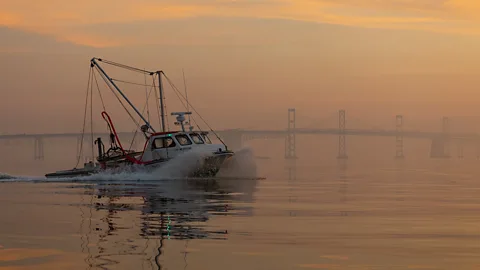 Jay Fleming
Jay FlemingFor decades, Maryland has been synonymous with crabbing. But as the Chesapeake Bay's "watermen" fade away, a young TikTok-famous fisherman is hoping to revive it.
It's 05:00 and still dark when Luke McFadden sets out from Maryland's Bodkin Point to start his day. His boat, the FV Southern Girl, slowly makes its way down the creek and out into the open waters of the Chesapeake Bay, the largest estuary in the United States.
Stretching from the northernmost tip of Maryland down to southern Virginia, the 200-mile-long Chesapeake Bay is made up of 11,684 miles of shoreline (more than the entire US West Coast) and is an integral part of the US Mid-Atlantic's economy. It also serves as the workplace for thousands of men and women seeking to make a living from its bounty.
"Being a crabber is all I've ever wanted to do," McFadden said, leaning against the hull of his boat after a day on the water. On shore, dozens of metal crab traps are stacked to be baited and set across the bay the following morning.
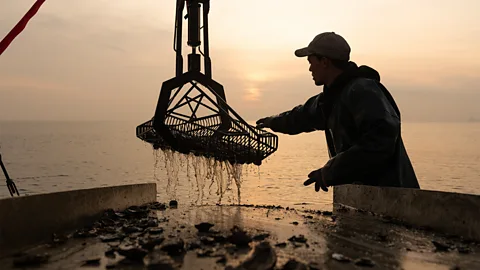 Jay Fleming
Jay FlemingFishing has long been a way of life around here. Scientists have found evidence of Native Americans relying on the region's crabs and oysters as a food source long before Europeans showed up. In 1608, English explorer John Smith sailed across the Chesapeake and wrote in his journal that oysters were "as thick as stones". Ever since, people have been fishing for crabs and oysters here in a more-than-400-year-old tradition that continues to this day.
According to the National Oceanic and Atmospheric Administration (NOAA), the Chesapeake Bay yields more than 500m pounds of seafood each year. Its vast tidal wetlands and combination of freshwater, saltwater and brackish water make for an ideal breeding ground for fish and shellfish. And while more than 3,600 plant and animal species thrive here, one has become so iconic that they're virtually synonymous with the bay and the state of Maryland itself: blue crabs, whose sweet, buttery flavour make them highly prized across the nation.
Known as Callinectus sapidus, which translates to "beautiful savoury swimmer", Chesapeake Bay blue crabs are only harvested from April through November and hibernate during the winter months, building a fat reserve that results in its uniquely delicate taste. As a result, crabbing isn't just an important valuable part of the region's $600m annual seafood industry, but an integral part of the region's identity. In fact, if you ask most Americans what Maryland is best known for, they're likely to say crabs – specifically those from the Bay that McFadden fishes.
Yet traditional "watermen" – a regional term encompassing fishermen, oystermen or crabbers like McFadden – are a dying breed. In the 1990s, close to 10,000 licensed watermen worked on the Chesapeake Bay. Today, that number is less than half, as aquaculture and the processing of fish into oils and supplements have largely supplanted them. What's more, the NOAA estimates the average age of watermen working on the Chesapeake is around 60 years old. But at 28, McFadden is an anomaly – and not just because of his age.
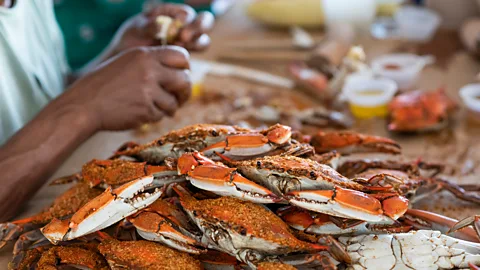 Jay Fleming
Jay FlemingWhile most watermen enter the profession generationally, McFadden has no family in the business. Instead, he grew up fishing and crabbing in the Bay and saved enough money from birthdays and chores to buy his first boat, a rowboat, when he was just 11 years old. After shadowing a family friend who was a crabber, he began pursuing the tradition full-time at 18. Ten years on, he's still at it. "I guess I was just too dumb to quit," he laughed.
But what truly sets McFadden apart is his unlikely fame on social media. By posting daily snippets of his life and shining a spotlight on the Chesapeake Bay and this age-old tradition, McFadden has amassed 1.7m followers on TikTok. His videos range from demonstrations on how to eat a crab and how to bait a trap to the trial and errors of owning your own business. McFadden says he began building his social media presence to make more money by selling his crabs direct to customers, never imagining he'd gain the attention of so many.
"To me, it's just day-to-day life," he said. "But I get it: it's an obscure job."
One only needs to watch a few of McFadden's videos to understand his allure. His telegenic looks, comedic delivery and deep Maryland drawl give his content a realness that's often lacking in the digital world. "I think what appeals to people is his authenticity. The Luke you see on screen is the same one you would meet in real life," says his wife, Lindsey. "The everyday grind is relatable to a lot of people. Most people are out there working hard every day, but it's not something you usually see on screen."
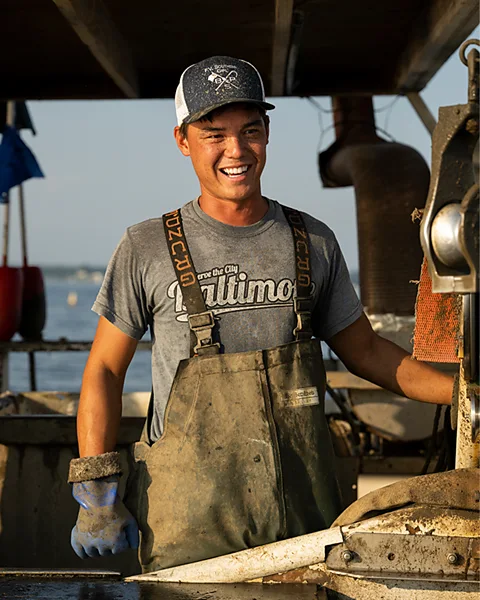 Jay Fleming
Jay FlemingThough McFadden quickly found success online, he experienced pushback from fellow watermen suspicious of his motives. "A lot of people are crabbers because they don't want to be bugged. Most are very private, so I think they wondered why I was doing it," McFadden said. "And it's a cutthroat industry – there's no room for part-timers." But after seeing his dedication to the job and his commitment to the tradition, he says that most of his fellow watermen have come around in recent years.
"If my content shines a light on our way of life, then that's great. I want to do anything I can for the industry. There's not many of us," he said.
McFadden is now shipping crabs nationwide, and recently opened his own crab stand, Bodkin Point Seafood in Glen Burnie, Maryland. Yet, between fishing for crabs and selling his crabs, McFadden frequently works 12-hour days, seven days a week. The physical labour involved in crabbing – hauling heavy crates of bait, pulling up traps and shaking them over the rails – is backbreaking work. "I'm in my 10th year of running my own boat, and I've never done anything but physical labour," he said. "I'm only 28, but I'm starting to feel it physically."
This backbreaking work is one of the main reasons why Maryland's crabbing heritage is now in jeopardy.
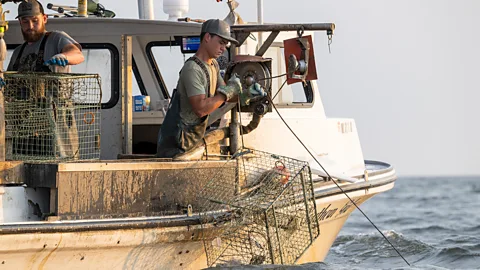 Jay Fleming
Jay FlemingJeff Harrison, a waterman from Tilghman Island (a three-square-mile isle located in the Chesapeake Bay), has been working on the Bay full-time since the 1970s. A fifth-generation waterman, he acknowledges that he is likely the last in his family to make his living from the water here. "I have three sons and none of them have followed me into the profession," Harrison said.
Harrison began working on his father's boat as a nine-year-old. At 16, he became a full-time waterman, catching oysters in the winter and crabbing in the summer. He wakes up at 03:30 each morning during the April-through-November crabbing season, and by the time he steps off the boat, he will have worked a 12-hour day. "I love being on the water. It gets in your blood and becomes a part of you," he said.
Like Harrison, most watermen say there is nothing else they'd rather be doing, though there are many challenges. Climate change, pollution, invasive species and disease are just a few of the environmental factors increasingly impacting harvests. In 2021, the Chesapeake Bay Foundation, an organisation dedicated to restoring the health of the bay, reported its lowest crab numbers on record, and subsequent reports indicate only a nominal rise in crab numbers every year since.
In addition to environmental challenges, becoming an independent waterman is an expensive endeavour. Between buying a boat and equipment and paying a crew, Harrison estimates the average waterman must invest hundreds of thousands of dollars to get off the ground – and costs of fuel, metal, bait and labour are only rising.
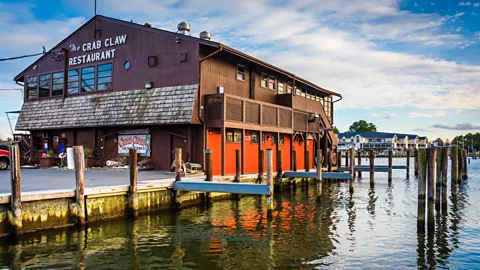 Alamy
AlamyWhile the average cost of a bushel of crabs (which can range from 84 small crabs to 48 jumbo ones) can run anywhere between $300-$400, most crabbers don't sell directly to customers and just get a cut of what they sell to a restaurant or wholesaler. "Your costs used to scale better with the price of seafood," said McFadden.
Where to eat authentic Maryland blue crabs:
• Harris Crab House on Kent Island is a waterside institution serving traditional Maryland crab feasts, oysters and other fresh caught seafood.
• Cantler's Riverside Inn in Annapolis was established 50 years ago by waterman Jimmy Cantler and overlooks the scenic Mill Creek.
• The Crab Claw in St Michaels is a seasonal crab deck serving steamed crabs, oysters and soft-shell crabs – a regional delicacy.
Increased regulations by government and environmental groups have also taken their toll. Whereas Harrison could once fish six days per week, now he is regulated to five. Watermen are also limited on how many bushels of oysters and crabs they can catch.
In the nearby town of Kent Narrows, Harris Seafood has been operating since 1947 and is the last year-round seafood processing plant in Maryland. Owner Jason Ruth says the economy is currently the biggest challenge facing watermen. "The demand for oysters has gone down as people are not spending the money or eating out as much."
After 40 years in the industry, Ruth has experienced his share of ups and downs, from securing steady labour (most crab-picking and oyster houses employ migrant workers) to disease that decimated the oyster population in the 1990s.
 Jay Fleming
Jay Fleming"This area was a watermen's community for centuries," he said, gesturing across the inlet where he has lived his entire life. "Now it's all overrun with million-dollar homes and big boats. The youth are heading to the big cities, finding other jobs."
Indeed, McFadden knows this centuries-old tradition needs more than just his TikTok presence to survive. He frequently collaborates with award-winning photographer Jay Fleming – whose book, Working the Water, is a photographic narrative of Chesapeake Bay area watermen – to educate people on the local ecosystem and raise money for local museums. Fleming and McFadden also credit organisations like the Chesapeake Bay Maritime Museum and the Annapolis Maritime Museum, whose exhibits and tours – such as those on the skipjack boat Wilma Lee – serve to educate the public on local watermen.
Still, McFadden knows he may be among the last of the working watermen. But that's not stopping him from continuing to tell his story. "I'm trying to change the perception of the commercial fisherman in the United States," he said. "So if people get invested in my story, that's great, because someday if my kids decide they want to be crabbers, I hope they can."
--
If you liked this story, sign up for The Essential List newsletter – a handpicked selection of features, videos and can't-miss news, delivered to your inbox twice a week.
